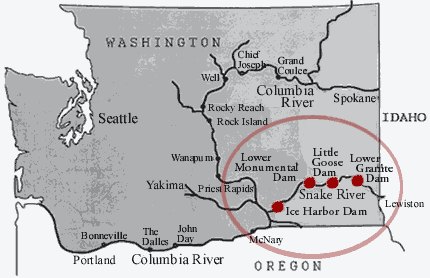forum
library
tutorial
contact

What's the Backup Plan?
by Tom MeiseSpokesman Review, April 28, 2011
|
the film forum library tutorial contact |

|
What's the Backup Plan?
by Tom MeiseSpokesman Review, April 28, 2011 |
 Harvey Morrison (Letters, April 22) is a bit confused. He states the run-of-the-river dams can not store water for later use in other seasons. To dam means to stop the flow of water and hold it in a basin, thereby controlling the flow over a longer period.
Harvey Morrison (Letters, April 22) is a bit confused. He states the run-of-the-river dams can not store water for later use in other seasons. To dam means to stop the flow of water and hold it in a basin, thereby controlling the flow over a longer period.
Where does he propose to store the power created by the wind for use when there is no wind? In my world, the wind does not blow every day nor does the sun shine every day. We need clean, reliable power on a daily basis 24/7.
If the dams are removed, he will be paying dearly for the salmon who, by the way, seem to be on the comeback. Thousands of jobs will be lost and tens of thousands of acres of food-producing land will be out of production. Also, he will add thousands of trucks to the roadways to haul the goods now moved by barge up and down the river through these worthless dams.
No! The Columbia-Snake River system is one of the largest inland water transportation systems in the world. Far too valuable for too many people to abandon (sic). Water is the cheapest way to move freight.
Do a little research.
Related Pages:
Snake Dams Not Worth It by Harvey Morrison, Spokesman Review, 4/19/11
Regarding the Lower Snake River (LSR) dams bluefish does the research:Our Mission at www.bluefish.org is to facilitate an open and honest dialogue concerning the plight of Idaho's wild Salmon and Steelhead. The fate of these fish will largely be determined by government agencies and the funding and authorizations that they receive from Congress. It is hoped that the growing library of news and reports will assist the public and these decision-makers in making well-informed choices regarding the recovery of Idaho's anadromous fish.
- STORAGE: Harvey Morrison is correct when he states, "As run-of-the-river dams, they (LSR dams) can't store water for use in other seasons." In contrast, flood-control dams (such as nearby Grand Coulee dam) are of a different design and DO store water "thereby controlling the flow over a longer period." Notably during salmon migration, the LSR dams are not used to level (or "shape") power from wind generation. Outside this migration window, shaping benefits from these dams are minimal.
- TRANSPORTATION: Tom Meise suggests that "Water is the cheapest way to move freight." Setting aside the energy expended in lifting and lowering barges through LSR locks, moving freight by rail IS about 10% higher in energy use than by water. However, lock flushes cost BPA customers (50,560 MWh x $32.4/MWh =) $1.6 million in foregone electricity sales. Also note that in 2011, $60 million in lock repairs were paid entirely by taxpayers as the "Inland Waterways Trust Fund is broke" says Army Corps of Engineers (ACOE) dam manager at Lower Monumental Dam.
- JOBS: Tom Meise suggests that "If the dams are removed. . . thousands of jobs will be lost." Upon studying economic effects, the ACOE estimated that in the long-term 1,842 jobs would be created but 3214 jobs would be lost for a net loss of 1,372 jobs. Job creation arises primarily from recreation related jobs and jobs arising from Operations and Maintenance of New Power Plants and related Transmission Lines. Job losses come primarily from 1,579 due loss of irrigation on 13 farms and 1,415 jobs lost due to reduction of ACOE spending. In the short-term, ACOE estimated that 20,821 jobs would be created from the activities that dam breaching would entail. (see www.nww.usace.army.mil/lsr/final_fseis/study_kit/Main_Report/chap5.htm Table 5.14-3 & Table 5.14-2)
- IRRIGATION: Thirteen farms pump water from the Lower Snake to irrigate 36,224 acres. A quarter of this acreage is planted in trees for paper production (101,600 acre-feet x 0.342 MWh/acre-feet x $32.4/MWh = $ 1.1 million foregone hydropower revenue). Currently, water is pumped from Ice Harbor reservoir to cropland 20 to 560 feet above the surface of the reservoir (see www.bluefish.org/iceharbr.htm). Under a dam breach alternative, ACOE considered new pumping stations to pump water an additional 80 feet in elevation, the free-running river that much lower than the current impounded reservoir. ACOE concluded that pump modifications would cost more than the farmland was worth and noted substantial job loss to Hispanic populations in its summary of alternatives.
learn more on topics covered in the film
see the video
read the script
learn the songs
discussion forum
